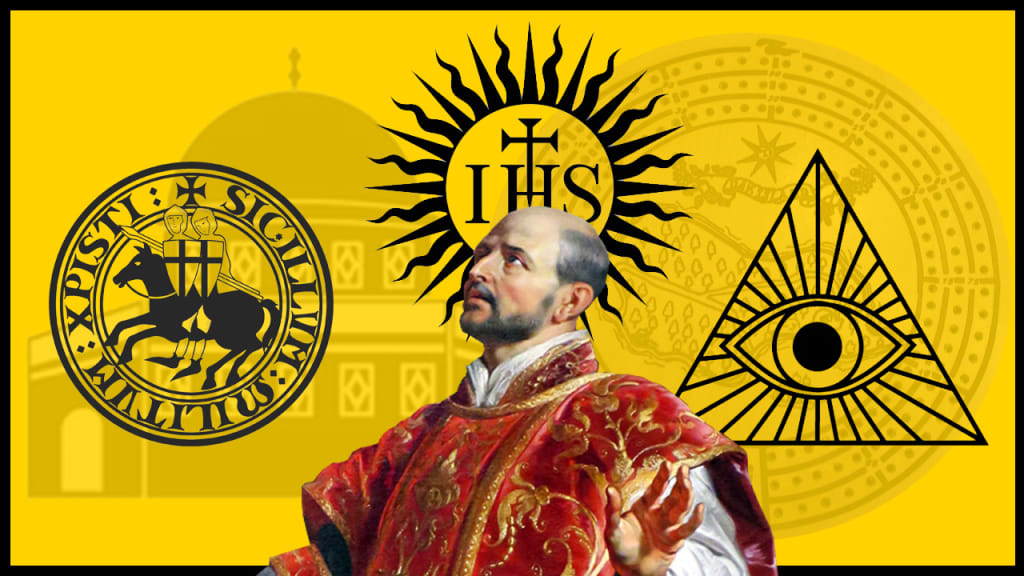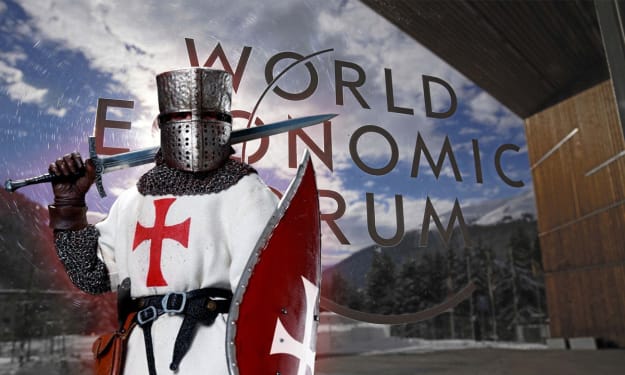Did the Jesuits emerge from the seeds of Templar conquest?
Ignatius of Loyola and the Pamplona epiphany

Goodness knows how historians pieced together world events before the advent of television and the internet, when the written word was the domain of the nobility whose versions of the passage of time were largely dictated by the ruling classes.
The church and educated interest groups did their best to inform and teach the masses, but they all did so with a tight grip on the narrative which was crafted to serve their agendas.
The history books tell us that after their dissolution in 1312 – following a crackdown by Pope Clement V in France when they fell from grace due to accusations by King Philip IV about deviant sexual rituals – the Knights Templar were stripped of the special privileges they had been granted by the Vatican and, if rounded up, had been tortured into giving false confessions and then burned at the stake.
No doubt many of the group’s leaders met a pretty grisly end but it was such a powerful and wealthy movement, with tentacles stretching across the continent, that the notion it was completely eradicated in 1312 seems a pretty ridiculous concept.
A far more likely scenario is that the knights simply removed their distinctive white mantles, emblazoned with a red cross, and fled to some safe haven… with Scotland thought to be the most likely first refuge, at Kilwinning Abbey in Ayrshire.
Coincidentally perhaps, but Kilwinning is also the site of the oldest Masonic site in the world, Lodge Mother Kilwinning, with origins allegedly dating back to the 12th Century.
Legend has it that Kilwinning Abbey itself was also founded between 1162-88 and built by stonemasons who had travelled from Europe, more than 20 years after the formation of the Knights Templar.
Now this is far from being conclusive evidence of a link between the Templars and the Masons but you’d have to concede it’s a pretty big coincidence that a small corner of the Garnock Valley in Scotland could be ground zero for the foundation of the Freemasons and perhaps once a resting place for the Holy Grail.
But, moving on, the period from the 12th to 16th centuries was a turbulent period of European history that gave rise to the Inquisitions and the Catholic hunt for heretics, beginning in France to combat the religious deviation of the Cathars and the Waldensians – the Cathars, in particular, upsetting the Catholic authorities with their ideas about two gods, one good and the other evil.
But broadly speaking the Inquisitions were an attempt by the Vatican to weed out converts, often Jews or Muslims, perhaps even Templars, who professed to follow the religion but were simply doing so for expediency.
Out of this period of Catholic turmoil the Jesuits, or Society of Jesus, eventually appeared, founded in 1540 by Ignatius of Loyola and six companions with approval from Pope Paul III.
A career soldier of noble birth, Ignatius joined the military at 17 and quickly developed a reputation as a womaniser, who used his privileged status to escape prosecution for violent crimes allegedly committed at carnival time with his priest brother.
However his diplomacy and leadership qualities earned him the trust of Antonio Manrique de Lara, second Duke of Najera, but at the Battle of Pamplona during the Italian War of 1521-26 he was severely injured when a French-Navarrese expedition force stormed the fortress of Pamplona and a cannonball, ricocheting off a wall, shattered his right leg.
Aged 30, he returned to his father's castle in Loyola where he underwent several surgical procedures to repair the leg, but it was left shorter than the other meaning he would limp for the rest of his life, his military career also shattered.
Then, while recovering from the surgery, Ignatius allegedly had an epiphany and underwent a spiritual conversion. Inspired by Ludolph of Saxony’s De Vita Christi, he vowed to follow the example of Francis of Assisi and other inspirational monks.
After recovering his mobility, he resolved to begin a pilgrimage to the Holy Land and in March 1522 visited the Benedictine monastery of Santa Maria de Montserrat to confess his sins, casting off his fine clothes and hanging up his sword and dagger at the altar during an overnight vigil.
For the next year he is believed to have lived in Manresa (Catalonia) doing chores at a hospital in exchange for food and lodging, while spending much of his time in a cave nearby where he practised asceticism, praying for seven hours a day and formulating the fundamentals of his “Spiritual Exercises”.
In 1523 he began his pilgrimage to the Holy Land, with the intention of settling there, but was soon sent back to Europe by the Franciscans, returning to Barcelona where, at the age of 33, he attended a free school in preparation for university entrance, later enrolling at the University of Alcala where he studied theology and Latin from 1526-27.
But at university he attracted the attention of a group of devout Alumbrados, women who had been called before the Inquisition because of their zeal for Franciscan reform. The Alumbrados (the Illuminated) were practitioners of a mystical form of Christianity in the Crown of Castile during the 15th and 16th centuries, who believed the human soul could achieve such perfection it could, even in the present life, sense the presence of God and comprehend the mystery of the Trinity.
They professed that all external worship was superfluous and sin impossible in this state of complete union with God, so followers could indulge their sexual desires and commit other sinful acts without fear of staining their souls.
As a result of this association with the Alumbrados, Ignatius was also singled out for interrogation, but was later released and next moved to France to study at the University of Paris – attending the ascetic College de Montaigu before moving on to the College Sainte-Barbe where he did a master's degree.
He quickly became close to six companions – Spaniards Alfonso Salmeron, Diego Laynez and Nicholas Bobadilla; Simao Rodrigues, a Portuguese; a Basque, Francis Xavier; and Peter Faber, a Savoyard – and in 1539 they formed the Society of Jesus (Jesuits) approved in 1540 by Pope Paul III. Ignatius, chosen as the first superior general of the order, was given the title "Father General".
Members of the society were expected to accept orders to go anywhere in the world, where they might be required to live in extreme conditions, to spread the Catholic doctrine.
And there’s little doubt that Jesuit missionaries were instrumental in spreading Catholicism to the world, establishing missions across the globe from the 16th to the 18th centuries. They had successes and failures in Christianising native peoples but also met with controversy, being expelled from most countries in Europe and European colonies by the Catholic church after 1759, although this suppression was lifted in 1814.
Across the north Atlantic Ocean, approximately a century before the Jesuits’ official appearance, work was underway at Rosslyn Chapel, which dates back to 1446 when it started life as a family chapel for Sir William St Clair, who died in 1484 while the building was still incomplete.
Under the supervision of his son, Sir Oliver St Clair, work continued but the chapel’s original design was never completed and, following the Reformation, it fell into disrepair with Oliver Cromwell’s troops attacking Rosslyn Castle in 1650 and stabling their horses inside the chapel.
Following a period of Victorian repair and restoration, the chapel was rededicated in 1862 and weekly services began again. The beauty of its setting and the mysterious symbolism of its ornate stonework have attracted and intrigued visitors ever since.
Practically every surface inside and outside the chapel is carved in an outstanding display of craftsmanship that includes angels, green men and what appears to be Templar and Masonic symbolism.
No definitive record exists of the St Clair dynasty in Scotland, but it is believed to extend back to Saint-Clair-Sur-Epte in Normandy and William of Saint-Claire, who accompanied Saint Margaret of Scotland, the great-granddaughter of King Ethelred the Unready, in 1068 on the final leg of her return from exile in Hungary.
Margaret eventually married Malcolm III of Scotland, who supposedly granted William of Saint-Claire the barony of Roslin in return for his service.
Fast forward a couple of centuries and we arrive at Sir William St Clair, the eighth Baron of Roslin and son of Sir Henry St Clair, the seventh baron. Sir William, who had been a close associate of Robert the Bruce, was killed in 1330 during the Battle of Teba in southern Spain, where he fought alongside Sir James Douglas against the Moors... the Muslim populations of the Maghreb, Iberian Peninsula, Sicily and Malta during the Middle Ages.
And, wouldn’t you know it, the eighth Baron of Roslin had also fought in the Crusades and could trace his lineage back to Robert De St Clair, who was born in Normandy in 1190 and married Eleanor De Dreux, daughter of the Count of Dreux. Now, is that a French connection, or what? Had Sir William St Clair been a Templar knight during his time in the Holy Land and made Roslin a safe haven for his “brothers” fleeing France in 1312?
And what about Ignatius of Loyola and the Society of Jesus? Was its formation also a byproduct of the dynasty of the Templars and their exploitation of the Holy Land? Could the Alumbrados have also been influenced by the remnants of Templar conquest?
Well, you’d be hard-pressed not to find links between the Iberian Peninsula and the Templars, who had established themselves in the Spanish provinces of Castile and Leon, Aragon, Catalonia and Navarra, where they were stationed to protect the borders with the Muslim kingdoms.
Here they built “commanderies” to provide income to finance their military activities and the remains of their castles and fortresses punctuate the landscapes of Spain and Portugal, where they were built to protect the borders from attack.
As territories were gradually reconquered to the south, the Templars were given the task of colonising them and building commanderies, with the Iberian Peninsula having at least 82 strongholds (76 in Spain and six in Portugal)… more than existed in the Middle East.
But, to begin with, the Muslims possessed the richest parts of the peninsula with impressive cities such as Seville, Toledo and Cordoba. And, by the 11th Century, many historians believe that – through a mix of conversion and invasion – the majority of the Iberian population was Muslim.
But divisions began to appear in the caliphates and after 1118 the Muslims had a new fighting force to contend with... the Knights Templar.
The Christian kingdoms quickly embraced the Templars, who were exactly what they had been waiting for… brave, Catholic and prepared to police the front line, where they served as the shock troops who selflessly risked everything to protect Christianity.
In 1147 Lisbon was a Moorish city with a Muslim governor, a great mosque and a maze of streets called the Medina where ordinary people lived… the modern capital of Portugal part of the Umayyad caliphate that was conquered by a large Crusader force including many Templar knights.
And, if you follow the lineage back from Ignatius of Loyola’s former employer Antonio Manrique de Lara, second Duke of Najera, you come across more than a passing link between his family and the Templars. Perhaps explaining the Jesuit founder’s huge interest in visiting the Holy Land after his great epiphany as he recovered from his injuries in Pamplona.
The first Duke of Najera was Pedro Manrique de Lara, who was granted the title for his service to Ferdinand II of Aragon, the husband of Queen Isabella I of Castile and, as a result, King of Castile himself.
The lineages of both Pedro Manrique de Lara and Ferdinand II of Aragon represent a who’s who of the nobility of Aragon, Castile and Leon, Catalonia and Navarra that stems back to the 12th Century and Alfonso VII of Leon and Castile, and Pedro de Molina, a Castilian nobleman and military leader of the House of Lara, who was also Viscount of Narbonne and a fearsome military commander of Spain’s southern frontier.
Now it’s all just supposition but it also provides a neat timeline from the Templar knights to Castile and the Alumbrados, finally ending up with the formation of the Jesuits in 1540… seems like a potted history of “Illuminati” roots to me!
About the Creator
Steve Harrison
From Covid to the Ukraine and Gaza... nothing is as it seems in the world. Don't just accept the mainstream brainwashing, open your eyes to the bigger picture at the heart of these globalist agendas.
JOIN THE DOTS: http://wildaboutit.com






Comments
There are no comments for this story
Be the first to respond and start the conversation.